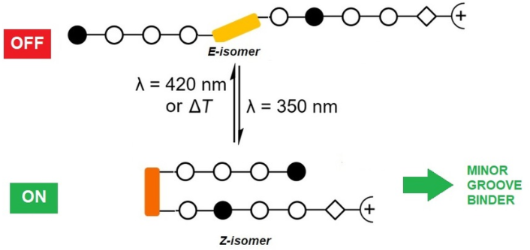Search results
Search for "thiazole orange" in Full Text gives 10 result(s) in Beilstein Journal of Organic Chemistry.
Chemical approaches to discover the full potential of peptide nucleic acids in biomedical applications
Beilstein J. Org. Chem. 2021, 17, 1641–1688, doi:10.3762/bjoc.17.116
- modified natural nucleobase that did not quench the fluorescence upon hybridization [148]. Köhler and Seitz introduced thiazole orange (TO, Figure 10), an intercalator dye originally designed for DNA [149], as a forced intercalation (FIT) probe in PNA. Because of rotation around the methine bond connecting
Synthesis and investigation of quadruplex-DNA-binding, 9-O-substituted berberine derivatives
Beilstein J. Org. Chem. 2020, 16, 2795–2806, doi:10.3762/bjoc.16.230
- a lower affinity [38]. Along the same line, the influence of the length and substituents of the side chains at the G4-DNA ligands have been assessed for quinolinium [43], indoloquinoline [44][45], phenanthroline [46], phenothiazine [47], and thiazole orange [48] derivatives. In these studies, the
Photocontrolled DNA minor groove interactions of imidazole/pyrrole polyamides
Beilstein J. Org. Chem. 2020, 16, 60–70, doi:10.3762/bjoc.16.8

- ligand to examine the propensity of these derivatives to bind to DNA. The known intercalator thiazole orange (TO) was chosen as indicator because it exhibits an intense fluorescence band at 526 nm when bound to DNA, whereas it is only weakly fluorescent in solution. The displacement of TO from its DNA
Identification of optimal fluorescent probes for G-quadruplex nucleic acids through systematic exploration of mono- and distyryl dye libraries
Beilstein J. Org. Chem. 2019, 15, 1872–1889, doi:10.3762/bjoc.15.183

- , the widely used fluorescent probes, such as thioflavin T (ThT, Φ = 0.25, in the presence of 22AG/K+ conditions) and thiazole orange (TO, Φ = 0.19 in the presence of 22AG/K+ conditions) [92], and approach the brightest G4-DNA probes developed so far, such as trialryimidazole IZCM-7 (Φ = 0.52, in the
Fluorogenic PNA probes
Beilstein J. Org. Chem. 2018, 14, 253–281, doi:10.3762/bjoc.14.17

- via the formation of high order complexes between PNA–dsDNA was also possible using a combination of PNA probes and CPP [122]. The use of a labeled PNA probe can be avoided by employing a fluorescence dye that can bind to PNA–DNA duplexes or triplexes, such as thiazole orange (TO) [123]. A
Halogen-containing thiazole orange analogues – new fluorogenic DNA stains
Beilstein J. Org. Chem. 2017, 13, 2902–2914, doi:10.3762/bjoc.13.283
- monomethine cyanine dyes 5a–d, which are analogues of the commercial dsDNA fluorescence binder thiazole orange (TO), have been synthesized. The synthesis was achieved by using a simple, efficient and environmetally benign synthetic procedure to obtain these cationic dyes in good to excellent yields
- fluorescence spectroscopy) and theoretical (DFT and TDDFT calculations) methods. Keywords: cyanine dyes; DFT calculations; green synthesis; nucleic acids; thiazole orange; Introduction Since the discovery by Lee and co-workers [1][2] that the old photographic dye thiazole orange, TO, (Scheme 1) has excellent
- properties as a fluorogenic noncovalent DNA or RNA binder, many representatives of this class of dyes have been developed [3][4][5][6][7]. Thiazole orange does not fluoresce in the free state in solution. Fluorescence appears when the rotation about the monomethine bridge between the two heterocyclic
Application of Cu(I)-catalyzed azide–alkyne cycloaddition for the design and synthesis of sequence specific probes targeting double-stranded DNA
Beilstein J. Org. Chem. 2016, 12, 1348–1360, doi:10.3762/bjoc.12.128

- -NH2 and two fluorophores bearing an azide functional group: one cyanine TO (derivative of thiazole orange [18]), and one coumarine MM14 kindly provided by M. P. Teulade-Fichou (Figure 7). The conjugation was conducted in a microwave reactor as for the polyamide tandem synthesis [2]. The details of the
A comparative study of the interactions of cationic hetarenes with quadruplex-DNA forming oligonucleotide sequences of the insulin-linked polymorphic region (ILPR)
Beilstein J. Org. Chem. 2014, 10, 2963–2974, doi:10.3762/bjoc.10.314
- -b′′′]tetraquinolizinium (5) and thiazole orange (6) were studied. It is demonstrated with absorption, fluorescence and CD spectroscopy that all investigated ligands bind with relatively high affinity to the ILPR-quadruplex DNA a2 (0.2–5.5 × 106 M−1) and that in most cases the binding parameters of
- case of thiazole orange (6) whose emission intensity increases by a factor of I/I0 = 1766. Within the series of heptamethine cyanine dyes 1a–e, the derivative 1d exhibits the largest light-up factor with I/I0 = 128. In contrast, the emission of coralyne (2), bis-quinolinium derivative 3 and the
- with the telomeric quadruplex 22AG (Table 2). For example, the cyanine derivative 1e shows the most significant difference between the binding affinity towards ILPR and the telomeric quadruplex (a2: Kba2 = 1.7 × 107 M−1; 22AG: Kb22AG = 3.9 × 105 M−1). Although thiazole orange (6) has a relatively high
A small azide-modified thiazole-based reporter molecule for fluorescence and mass spectrometric detection
Beilstein J. Org. Chem. 2014, 10, 2470–2479, doi:10.3762/bjoc.10.258

- also used for probing in life science comprises the heterocyclic thiazoles. This structural element can be found in commercial products, such as thiazole orange, SYBR® Green I or TOTO®, which are, e.g., used for DNA labeling. In these compounds the thiazole ring is part of a benzothiazole. We set out
Synthetic incorporation of Nile Blue into DNA using 2′-deoxyriboside substitutes: Representative comparison of (R)- and (S)-aminopropanediol as an acyclic linker
Beilstein J. Org. Chem. 2010, 6, No. 13, doi:10.3762/bjoc.6.13
- nucleic acids (TINA) [27][28], and by our group for fluorescent DNA base substitutions by ethidium [29][30], indole [31][32], thiazole orange [33][34], perylene bisimide [35][36] and phenothiazine [37]. This 2′-deoxyriboside substitution provides high chemical stability and conformational flexibility for
- we have shown with indole [32] and thiazole orange [33][34]. DMT-protected (R)-3-amino-1,2-propanediol 1 as a precursor was synthesized according to literature [29][43]. The hydroxy function of commercially available 2-propyn-1-ol was converted into an activated ester by 1,1′-carbonyldiimidazole and











































































































































